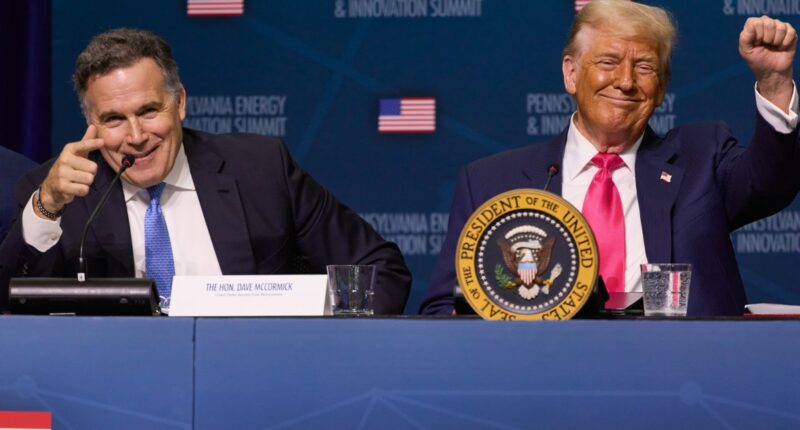Share this @internewscast.com
During a gathering that highlighted AI and fossil fuel interests in Pittsburgh, Pennsylvania, President Donald Trump was accompanied by cabinet members and leaders from prominent tech and energy companies including Google and ExxonMobil. He declared that Environmental Protection Agency head Lee Zeldin was “the most important person of the day.” Trump humorously added that Zeldin was expected to secure permits for the world’s largest electric power plant within a week. Following this event, the Trump administration lifted air pollution restrictions for coal-fired power plants, facilities producing chemicals for semiconductors, and other selected industrial sites, which had been established during the Biden administration.
If Trump implements his plans, future data centers may operate with more pollution compared to past structures. His approach isn’t just about halting renewable energy projects in favor of expanding coal and gas plants to meet the demands of AI data centers; he’s also intent on removing environmental safeguards.
Trump has expressed that being environmentally compliant incurs greater costs. In an October 2024 interview with Joe Rogan, he articulated this perception. With Zeldin’s appointment to oversee the EPA, he conveyed his commitment to “unleash US energy dominance” and transform the country into the “AI capital of the world.” On July 18th, the EPA announced significant layoffs, drastically reducing its research and development division.
“It costs much more to do things environmentally clean.”
At the Pennsylvania Energy and Innovation Summit, Trump attempted to take credit for private investments totaling around $36 billion for data center projects and $56 million for new energy infrastructure. The ceremony itself was mostly pomp and circumstance, but it’s telling that the Trump administration says it wants to make Pennsylvania a new hub for AI data centers. It’s a swing state that Republicans are eager to move into their column, but it’s also a major coal and gas producer. Sitting atop a major gas reserve, fracking in Pennsylvania (as well as Texas) helped usher in the “shale revolution” in the 2000s that made the US the world’s leading gas producer.
That was supposed to start changing under former President Joe Biden’s direction. He set a goal for the US to get all its electricity from carbon pollution-free sources by 2035. And in 2022, he signed the Inflation Reduction Act, which was full of tax incentives to make it cheaper to build out new solar and wind farms, as well as other carbon-free energy sources. If it had stayed intact, the law was expected to reduce US greenhouse gas emissions by around 40 percent this decade.
The law came at a crucial time for tech companies, which were expanding data centers as the AI arms race picked up steam. Electricity demand in the US is rising for the first time in more than a decade, thanks in large part to energy-hungry data centers. Google, Amazon, Microsoft, Meta, and other tech giants all have their own climate goals, pledging to shrink their carbon footprints by supporting renewable energy projects.
But Trump is making it harder to build those projects in the US. Republicans voted to wind down Biden-era tax incentives for solar and wind energy in the big spending bill they passed this month. The bill will likely decrease electricity generation capacity in 2035 by 340 GW, according to one analysis, with the vast majority of losses coming from solar and wind farms that will no longer get built.
All these new data centers still need to get their electricity from somewhere. “They won’t be powered by wind,” Trump said during the summit, repeating misleading talking points about renewable energy that have become a cornerstone of new climate denial. He signed an executive order in April, directing the Commerce, Energy, and Interior Departments to study “where coal-powered infrastructure is available and suitable for supporting AI data centers.” Trump, backed by fossil fuel donors, campaigned on a promise to “drill, baby, drill” — a slogan that he doubled down on again at the event. He also referenced the Homer City Generating Station, an old coal plant that’s reopening as a gas plant that will power a new data center.
The deals announced at the summit include Enbridge investing $1 billion to expand its gas pipelines into Pennsylvania and Equinor spending $1.6 billion to “boost natural gas production at Equinor’s Pennsylvania facilities and explore opportunities to link gas to flexible power generation for data centers.”
“They won’t be powered by wind.”
Data centers are a “main driver” for a boom in new gas pipelines and power plants in the Southeast, according to a January report from the Institute for Energy Economics and Financial Analysis (IEEFA). The Southeast is home to “data center alley,” a hub in Virginia through which around 70 percent of the world’s internet traffic flows through. Even if AI models become more efficient over time, the amount of electricity they’re currently projected to demand could lock communities across the US into prolonged reliance on fossil fuels as utilities build out new gas infrastructure.
Zeldin’s job now is essentially to remove any regulatory hurdles that might slow down that growth. From his first day in office, “it was clear that EPA would have a major hand in permitting reform to cut down barriers that have acted as a roadblock so we can bolster the growth of AI,” as Zeldin wrote in a Fox News op-ed last week. “A company looking to build an industrial facility or a power plant should be able to build what it can before obtaining an emissions permit,” he added. And after moving to roll back pollution regulations for power plants, the Trump administration is now reportedly working on a rule that would undo the 2009 “endangerment finding” that allows the EPA to regulate greenhouse gas emissions under the Clean Air Act.
Zeldin also writes that when it comes to Clean Air Act permits for polluters it considers “minor emitters,” the EPA will only meet “minimum requirements for public participation.” An AI Action Plan that the White House dropped on July 23rd proposes creating new categorical exclusions for data center-related projects from the National Environmental Policy Act (NEPA), a sunshine law that mandates input from local communities on major federal projects. The plan directs agencies to identify federal lands for the “large-scale development” of data centers and power generation.
There are other factors at play that could derail Trump’s fossil-fueled agenda, including a backlog for gas turbines in high demand. Solar and wind farms are still generally faster to build and a more affordable source of new electricity than coal or gas, and we could see some developers rush to complete projects before Biden-era tax credits fully disappear. One early bright spot for renewables was the fact that data centers used to train AI are theoretically easier to build close to far-flung wind and solar projects. Unlike other data centers, they don’t need to be built near population centers to reduce latency. They could also theoretically time their operations to match the ebb and flow of electricity generation when the sun shines and winds blow.
But so far, things are shaping up differently in the real world. “It’s just a race to get connected as quickly as possible,” says Nathalie Limandibhratha, senior associate US power at BloombergNEF.
Data center developers are also concerned that if they build facilities specifically to train AI closer to renewable energy, they could be left with stranded assets down the road. They’d rather keep building data centers close to population centers where they can repurpose the facility for other uses if needed. They also get more bang for their buck running 24/7, so data centers are leaning toward around-the-clock electricity generation from gas and nuclear energy (and nuclear energy has more bipartisan support than other sources of carbon-free energy).
“There’s no question right now that AI is driving greater fossil fuel use in the United States and really setting us back in terms of climate change,” says Cathy Kunkel, an energy consultant at IEEFA. Tech giants Google and Amazon made announcements coinciding with the Pennsylvania summit committing to purchasing hydropower and nuclear energy, respectively. But their most recent sustainability reports show that their greenhouse gas pollution is still growing, taking them further away from their climate goals of reaching net zero emissions.
“If [tech companies] wanted to meet their sustainability goals, they could do so,” Kunkel says. “They’re getting a free pass, obviously, from the Trump administration.”






